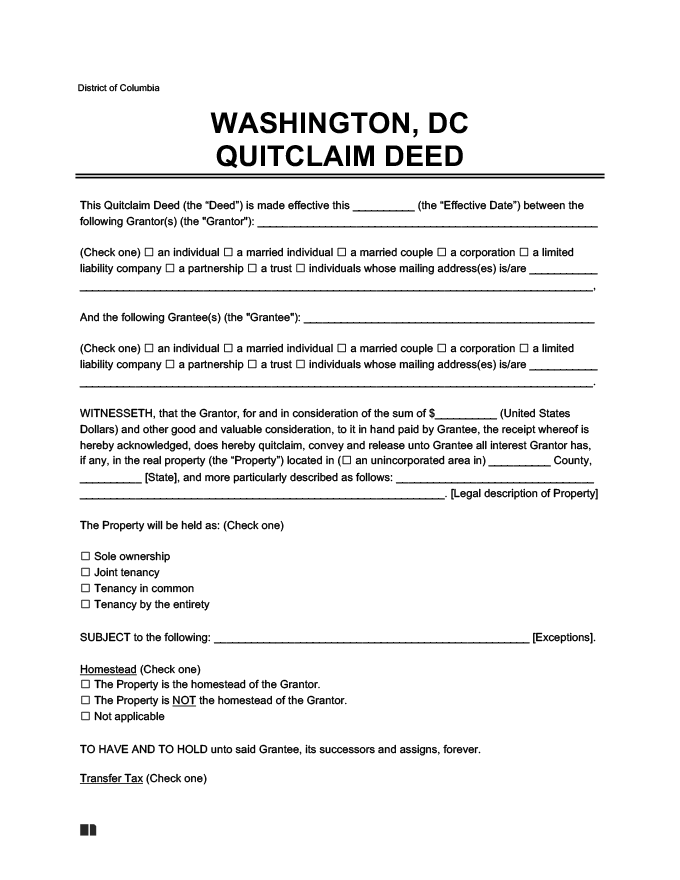Washington, DC quitclaim deed allows for simplified, warranty-free transfer of real estate between one party and another. Because quitclaim deeds do not carry warranties or guarantees related to the title, they are typically used for property transfers between individuals who know and trust one another, including property transfers between parents and children or to add or subtract a spouse from the property title.
Legal Framework
D.C. Code § 42-601 lays out the requirements for quitclaim deeds in Washington, DC, including sample language that can be used to record that deed.
Additionally, a quitclaim deed must meet the following requirements:
Legal Description
The legal description is the section that precisely identifies the property being transferred. It typically includes several elements:
- Lot and square number: This is the most common way to identify property. It refers to a specific plot within a designated square.
- Assessment and taxation number: If assigned by the Office of the Surveyor, this unique number can also pinpoint the property.
- Subdivision and reference information: If the property is part of a recorded subdivision, the deed will reference the subdivision plat and any specific lot number within it.
Signing
According to D.C. Code § 42-401, the quitclaim deed needs to be signed by the grantor, or the person transferring the property, and the grantee, or the person receiving the property, and notarized.
Terminology
In Washington, DC, there’s no specific terminology used for a quitclaim deed beyond the standard term itself. It’s simply referred to as a “quitclaim deed.”
Additional Documents
Tax Form FP-7/C must accompany the quitclaim form. In addition, the Document Intake Sheet will need to be filled out and filed with the Recorder of Deeds.
Filing
- Under the District of Columbia Code, specifically within Title 42, Chapter 4, and Chapter 12, the process for recording quitclaim deeds is clearly outlined.
- These legal documents can be submitted for recording at the office of the Recorder of Deeds. The submission can be made in two ways: by physically visiting the office to record the deed in person or through the convenience of online submission.
Validity Requirements
A valid quitclaim deed form must include a number of essential elements:
- A full legal description of the property that includes not only the address, but information about the property’s boundaries, which can be used to assess the actual location.
- The names of all parties involved in the transfer.
- A completed notary certificate.
- All additional forms needed to validate the transfer.
Failure to include all relevant information as part of the real estate transaction may prevent the transaction from being recorded properly, which could invalidate the transfer. If the quitclaim deed is invalid, the grantor could retain ownership of and responsibility for any issues with the property until it is taken care of.
Content Requirements
Ensuring the deed has all the necessary content will not only help the transaction proceed more smoothly but may make it easier to ensure that it is valid. The state provides sample language in the “Fee Simple Deed” section that can be modified to fit the needs of a quitclaim deed. It includes:
- The date of the transfer.
- The name and address of the party making the transfer.
- The consideration, or funds paid, for the property.
- The grantee or party receiving the property.
- The legal description of the property.
Quitclaim Deeds vs. Other Property Transfer Methods
| Quitclaim Deed | Transfer of property that does not convey any warranties against liens or encumbrances on the property, which means that the new owner will assume any risks. Transfers property more quickly, with no disclosure period or need to search for issues with the title. |
| General Warranty Deed | Traditional method of transferring property; includes a full warranty that notes that the property does not have any liens or encumbrances. May leave the grantor facing more risk when transferring the property. |
| Special Warranty Deed | Transfer of property that offers a warranty only for the period when the property was owned by the current grantor. Provides some protection to the new buyer of a property but does not convey the same level of protection as a full warranty deed. |
| Transfer-on-Death (TOD) Deed | Transfers the title directly when the current owner of the property dies. Must be filed before the death of the current owner, but does not change their rights to the property during their lifetime. |
| Life Estate Deeds | Creates two separate interests in the property: the life interest, which continues through the life of the current owner, and a remainder interest, which is valid after the death of the current owner. |
